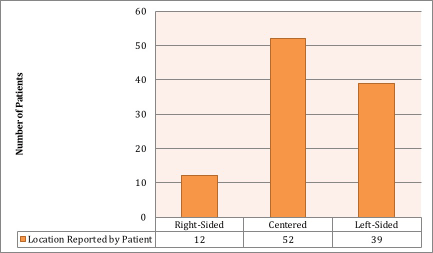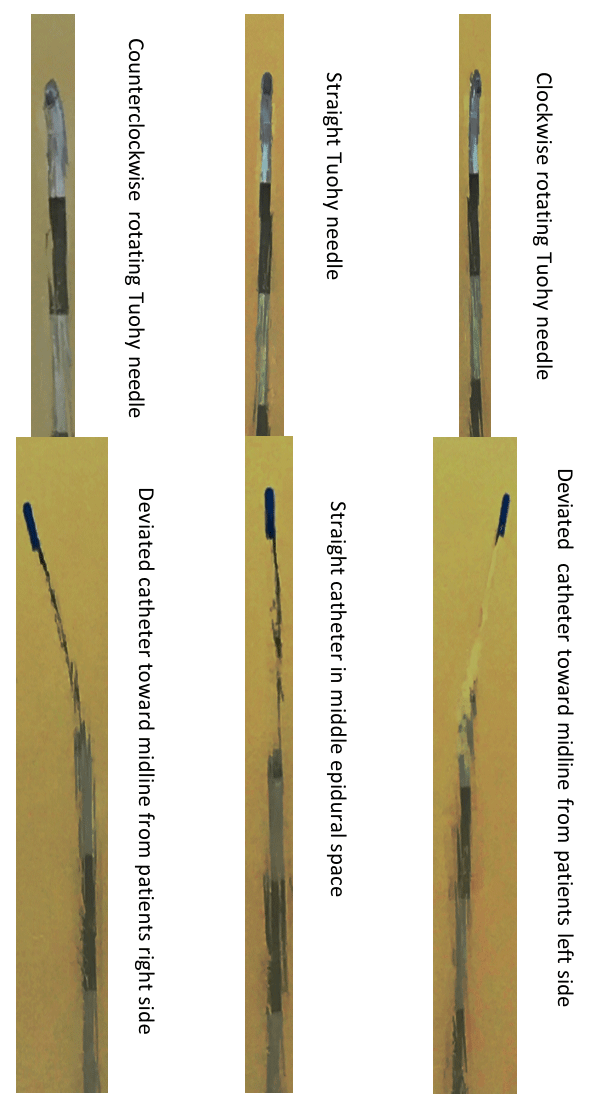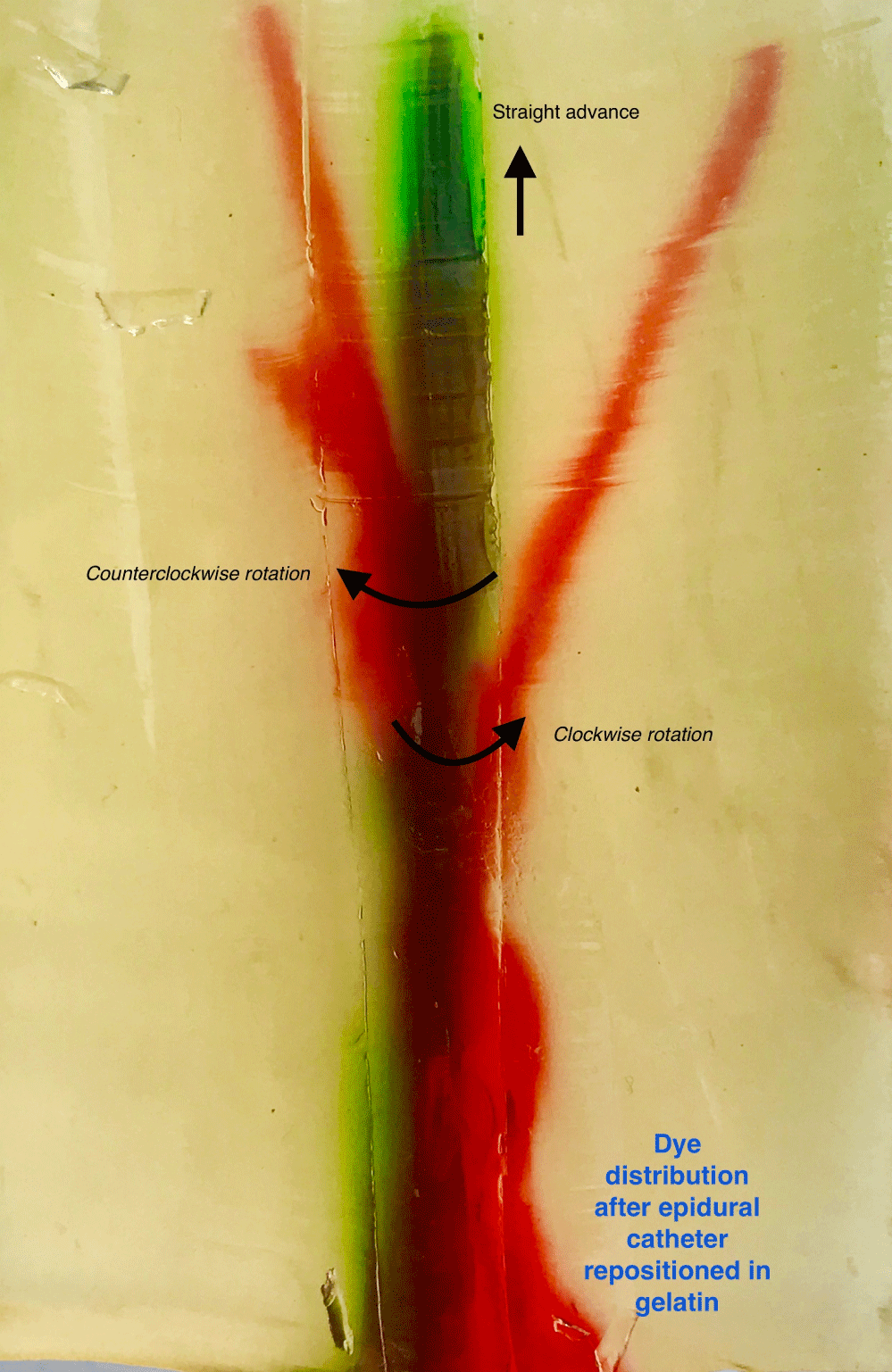Translational Perioperative and Pain Medicine (ISSN: 2330-4871)
ARTICLE DOI: 10.31480/2330-4871/066
RESEARCH ARTICLE OPEN ACCESS
Correct Positioning of Epidural Catheters is the Key to Avoiding Unilateral Labor Analgesia
Jack Zhang
Department of Anesthesiology, Parkside Medical Anesthesia Associates, Sisters of Charity Hospital, Buffalo, New York, USA
Jack Zhang, MD, PhD, Department of Anesthesiology, Parkside Medical Anesthesia Associates, Sisters of Charity Hospital, Buffalo, New York, USA, E-mail: zhangtext@gmail.com
Editor: Li-Ming Zhang, MD, PhD, Department of Anesthesiology, University of Pittsburgh, 200 Lothrop Street, UPMC MUH Suite N-467, Pittsburgh, PA 15213, United States of America, 412-648-6077, zhangl1@anes.upmc.edu
Received: February 02, 2018 | Accepted: March 28, 2018| Published: April 05, 2018
Citation: Zhang J. Correct Positioning of Epidural Catheters is the Key to Avoiding Unilateral Labor Analgesia. Transl Perioper & Pain Med 2018;5(2):33-37.
Abstract
Background
Incomplete labor epidural anesthesia is a frustrating experience for many anesthesiologists in their daily practice, especially in providing analgesia of labor and delivery; this study explores a practical approach to solve this issue.
Method
This study included a case series report of 103 labor epidural analgesia performed by an experienced anesthesiologist and gelatin model simulations of epidural needle and catheter repositioning. The epidural needle was adjusted based on the report from the patient regarding paresthesia-like sensation during the epidural placement. A gelatin model was used to simulate the effects of rotating Tuohy needle and redirecting an epidural catheter toward the middle epidural space on distribution of dyes in the space.
Results
Among 103 patients, there were 77% (39/51) of patients with one-sided sensation reporting to be on the left side while 23% (12/51) of patients were on the right side. With the epidural needle rotation based on patients' report, all patients received satisfactory analgesia.
The gelatin model demonstrated the rotated Tuohy needle at different bevel levels which had guided the epidural catheter to move toward the desired positions, simulating the maneuver of the catheter into the middle epidural space. The injected dye distribution in the gelatin model also successfully demonstrated the effects of the catheter repositioning on the spread of dye in the space. The videos were recorded to observe the simulation effects of three scenarios, a good tool for teaching purpose.
Conclusion
Maneuvering carefully by rotating Tuohy needle to reposition the catheter in epidural space is a reliable way to provide satisfactory epidural analgesia, which is observed in the clinical practice and simulation in a gelatin model.
Incomplete labor epidural anesthesia is a frustrating experience with not only unsatisfied analgesia but also dangerous situation when a stat cesarean delivery is involved for many anesthesiologists in their daily practice. It manifests as either asymmetrical or patchy block even though the epidural catheter is thought to be properly placed. Beilin, et al. [1] reported there were 12.2% patients with incomplete anesthesia 15 minutes after 13 ml of 0.25% bupivacaine was given. Pan, et al. [2] observed that approximately 5 to 8% of epidural blocks provided asymmetric analgesia in labor epidural analgesia. The incomplete epidural blocks usually require repeated boluses of local anesthetics to achieve better pain control. Some epidural catheters eventually need to be replaced for satisfactory analgesia.
Segal, et al. [3] attributed asymmetric blocks to the epidural anatomy and to the off-midline placement of the catheter in the space or excessive length of catheter advancement. The ideal approach is to place the catheter in midline and to position it in the center of the epidural space. I proposed that an epidural catheter could be maneuvered to prevent asymmetrical block by reporting the locations of paresthesia-like sensation during catheter insertion by patient.
Materials and Methods
After approval of the institutional review board, a total number of 103 cases for labor epidural analgesia were included in this investigation. A written informed consent was obtained from each parturient before the epidural catheter was placed. The patients with scoliosis and history of spinal surgery were excluded.
One attending anesthesiologist (the author) placed all epidural catheters. Patients were in a sitting flexed position. The midline approach at L3-L4 or L4-L5 interspace was used. The technique of loss-of-resistance to saline via 18-gauge, winged Tuohy needle (Perifix, B. Braun Medical, Inc., Bethlehem, PA) was applied. Once the epidural space was identified, several milliliters of normal saline (up to 10 milliliters) were injected. Then, a multi-pore catheter was threaded via the Tuohy needle. As the catheter tip was just passing through the opening of the needle, the patient was asked to identify the location of any paresthesia-like sensations. If the patient stated the sensation was in the middle of her spine or did not feel any stimulation, the catheter was advanced until 4 cm of the catheter was into the epidural space. If the patient identified the paresthesia- like sensation was located on the right or the left side, the catheter was withdrawn into the Tuohy needle (this is not recommended for any novice anesthesia provider). The needle was then rotated to the side opposite to the location where the sensation was reported, and the catheter was reinserted through the Tuohy needle. The patient was asked to identify any new paresthesia-like sensations. The maneuver was repeated by rotating the Tuohy needle gently and carefully by 30, 60 or 90 degrees incrementally until the patient felt that the sensation was in the midline. If there was any resistance on gentle retracting the catheter, the Tuohy needle and catheter should be completely taken out together to prevent shearing of the catheter by the sharp edge of needle tip.
After the epidural catheter was placed, a test dose of 3 ml of 1.5% lidocaine with 15 µg of epinephrine was injected to exclude intrathecal or intravascular placement. The catheter was then secured by tap on the back. A 5 ml dose of 0.2% Ropivacaine was given via the catheter to observe the initial effects of blockade in 5 to 10 minutes, namely, a warm feeling or tingling in the lower middle back and the gradual spread out of the warmth. An effective labor epidural would start to relieve the pain bilaterally and significantly in 20 min.
The patient's chart was reviewed after delivery to determine if a unilateral block occurred or if the epidural catheter needed to be replaced due to incomplete block.
Gelatin model to simulate catheter repositioning
Beef gelatin powder was purchased online. A ratio of 10 oz of the powder to 1 cup of water was used to prepare the gelatin block for practicing an epidural placement (Tuohy needle and catheter are the same as stated above). After the well-stirred and dissolved mixture in warm temperature (less than 140 F degrees) was cooled down, it was poured into a block mold and allowed to sit inside a refrigerator overnight. The ratio of mixture was adjusted to keep the gelatin block firm and also to allow the epidural catheter capable of penetrating through without much resistance. Attempts in the gelatin model were made to demonstrate three scenarios. One is for the epidural positioned with Tuohy bevel at horizontal level, to simulate that the patient was expected to report paresthesia in the middle of back and the catheter was assumed to advance in the middle epidural space. Secondly, Tuohy needle was rotated counter clockwise to simulate that the patient would state a paresthesia on the right side of back. The epidural catheter would be deviated toward the middle epidural space. Thirdly, Tuohy needle was rotated clockwise to simulate that the patient would state a paresthesia on the left side of back.
Observations were made on the dye distribution at each position. 2 cc of blue dye was injected via the epidural catheter at the position without a needle manipulation. Each of 2 cc of blue dye was injected into the catheter at the position with either needle clockwise rotation or counterclockwise rotation. Photos and videos were taken from the gelatin demos to show the effects of Tuohy needle rotation on deviating epidural catheter into the middle epidural space. The dye distribution from the catheter into the gelatin was used to demonstrate the effects of repositioned catheter in the epidural space on the dye redistribution.
Results
There were 103 cases included in this case study. One patient with severe scoliosis was excluded. 52 patients (50.5%) reported the epidural catheter was sensed in the midline of the spine. 39 patents (37.9%) reported the catheter on the left side and 12 of them (11.7%) reported feeling the catheter on the right side. The patients with center-sensed catheters did not need any adjustment of the Tuohy needle or the catheter. These 52 patients had a symmetric block and immediate pain relief. The 39 patients who reported a left-sided paresthesia required a clockwise rotation of the Tuohy needle to a maximal 90 degrees until they sensed the catheter in the midline. The 12 patients who felt a right-sided paresthesia needed a counter-clockwise rotation in the same fashion in order to achieve a sensation in the midline. Among the 51 patients with an initial sensation on either left side or right side, none of them had a unilateral epidural block. They all reported a gradual warm sensation in the lower middle back and then pain relief 15 min after receiving 5 ml of 0.2% Ropivacaine. There were 77% (39/51) of patients with one-sided sensation reporting to be on the left side while 23% (12/51) of patients were on the right side (Figure 1).
Figure 1: Number of patients with different locations (Right-Sided; Left-Sided and Centered) of paresthesia-like sensation.

Three scenarios were simulated in gelatin models. Figure 2 illustrates the relationship between the Tuohy needle bevel and deviation of the epidural catheter from the needle. It clearly shows that the rotation of the Tuohy needle will change the direction of the advancing catheter. The demonstrations in vitro could have simulated the movement of the epidural needle and catheter in the human body.
Figure 2: Gelatin model shows relationship between Tuohy needle rotation and epidural catheter deviation. The middle one shows the un-rotated Tuohy needle with a horizontal bevel and the epidural catheter is straightly lined up without deviation. The left one shows Tuohy needle is rotated counterclockwise with tilted bevel and the epidural catheter is deviated from the axial of Tuohy needle. One on the right side is opposite. Tuohy needle is rotated clockwise and the epidural catheter is deviated from the axial of the needle.

Figure 3 is a photo taken for the dye distribution from epidural catheters. The blue dye was from a catheter inside an un-rotated Tuohy needle, simulating the scenario in which the catheter was placed in the middle epidural space. The red dye on the left-handed side of the photo was from the catheter after Tuohy needle was rotated counterclockwise and the catheter was deviated toward the middle line from the right side. While the red dye on the right-handed side was from one after Tuohy needle was rotated clockwise and the catheter was projected to the middle line from the opposite side. As we can see the location and relocation of the catheter will change the dye distribution pattern significantly.
Figure 3: Dye distribution in gelatin. After Tuohy needle is positioned and the epidural catheter is threaded through the needle. Tuohy needle is withdrawn from gelatin. The catheter is injected with dye in two different colors. The middle one in green color shows straight distribution of dye with straight position of Tuohy needle and catheter. The red strip on the left side shows dye distribution from a deviated epidural catheter in a counterclockwise rotated Tuohy needle. The red colored one on the right side is for the dye distribution from a deviated catheter in a clockwise rotated needle.

A supplemental video with 4 parts of experiments is included in this study to demonstrate the maneuver of Tuohy needle and epidural catheter in the gelatin model in lateral and AP (anteroposterior) views (https://youtu.be/oo_U0rwI2zI). Please open the link for self-explanation. Part 1 (lateral view) and Part 2 (AP view) demonstrate an un-rotated Tuohy needle and a straight advancing epidural needle in the gelatin model. Part 3 and Part 4 show the rotated needles and deviated catheters in the gel in AP view.
Discussion
Several factors, including misplacement of Tuohy needle, inappropriate positioning of the catheter, catheter migration in the epidural space, or abnormal epidural anatomy [3], contribute to the failure of an optimal labor epidural analgesia. Pan, et al. [2] reported an overall failure of 12% on a retrospective analysis of 19,259 deliveries.
6.8% of patients had their epidural catheters replaced and 1.5% had multiple epidural replacements. To achieve an effective labor epidural analgesia, the optimal conditions should be that the Tuohy needle is entered in the midline, the catheter is sitting in the middle of a normal anatomic space and the local anesthetic is evenly spread out. However, a radiographic study has shown that when a catheter is threaded beyond the tip of the needle into the epidural space it rarely stays midline [4]. Even an injection of contrast at the midline into the epidural space resulted in difference in density of contrast spread on either side of the midline [5]. These evidences imply the unilateral epidural analgesia is related to uneven spread of local anesthetics.
The anesthesiologist may not suspect there is a problem until unilateral anesthesia is reported; by then, it is usually too late to correct the placement. To overcome the deficiency, very large amount of local anesthetic with narcotics may have to be given to increase the spread the medication to the inadequately blocked dermatome [6]. Our effort has focused on keeping the epidural catheter to stay where the patient feels it is in midline which predictably ensures a symmetrical blockade. A future work needs to be done to reveal the symmetrical labor analgesia is consistent with the local anesthetic to spread bilaterally and evenly in the epidural space.
To achieve the goal, the patient must sit in an optimal upright position and the Tuohy needle should be placed in midline. Once the catheter is advanced through the tip of the needle the patient is required to report the location of the paresthesia-like sensation from the catheter. If it is felt in the midline or no sensation, the catheter is advanced by 4 cm. 52 Patients (50.5%) in this category achieved bilateral satisfactory analgesia, indicating successful symmetric labor anesthesia. The rest of the patients had epidural needle and catheter adjustment due to one sided paresthesia, all of which had optimal analgesia also. By taking 12% of incomplete analgesia into consideration reported in the past [2], we could potentially have prevented more than 12 patients from incomplete analgesia in 103 patients. Therefore, maneuver by rotating epidural catheters is potentially an effective way in providing complete labor analgesia. Figure 2 depicts maneuvering process in which a Tuohy needle is rotated, and an epidural catheter is repositioned in order to achieve the patient's reported midline position and presumably symmetrical labor analgesic effect.
In this study, 77% (39/51) of patients reported one-sided catheter sensation on the left side, while 23% (12/51) of patients reported on the right side. The result is consistent with the result of Beilin [1] and Ducrow [6]. They also found the incomplete analgesia occurred more predominantly on the right side (81% and 79% respectively) than on the left (22% and 21%). It was thought that epidural catheters tend to deviate to the left more often than to the right [1]. The major limitation of this observational study is that there was no control group to demonstrate the incidence of unilateral block without a rotating the Tuohy needle. The relationship between the off-midline location of paresthesia-like sensation and incidence of unilateral block needs to be investigated in the future. A study should be designed to observe significant difference of analgesic amounts including top-up doses in labor epidural analgesia between the maneuver group and unmaneuvered ones. However, an important precaution for avoiding sheared catheter should be applied into practice. The catheter should be retracted into the Tuohy needle without resistance. Otherwise, the needle and catheter have to be taken out together for a new epidural insertion attempt. Ideally, the manufacturer of the epidural needle should blunt or round the inner edge in the tip of Tuohy needle in order to decrease the risk of shearing the plastic catheter. The maneuver has not been determined whether it could increase the risk of accidental dural puncture to induce postdural puncture headache.
The gelatin model served as a model to simulate the maneuver of Tuohy needle and the epidural catheter. It has shown that rotation of Tuohy needle changed the needle moving path and dye distribution pattern and location. This offers additional evidence that this maneuver is potentially applicable in clinical practice to avoid one sided block. Large clinical trial is needed before a firm conclusion is reached.
In conclusion, maneuvering by rotating Tuohy needle to reposition the catheter in epidural space could be an effective and reliable way to provide symmetrical epidural analgesia. However, patients are required to report the location of the paresthesia-like sensation induced by the catheter placement to ensure the midline placement. The effectiveness and safety of such technique need to be further studied in a large-scale studies.
References
- Beilin Y. Treatment of incomplete anesthesia after placement of an epidural catheter and administration of local anesthetic for women in labor. Anesthesiology. 1998;88:1502-6.
- Pan PH. Incidence and characteristics of failures in obstetric neuraxial anesthesia and anesthesia: a retrospective analysis of 19,259 deliveries. Int J Obstet Anesth. 2004: 14:227-233.
- Arendt K, Segal S. Why epidurals do not always work. Rev Obstet Gynecol. 2008:1(2): 49-55.
- Hogan Q. Epidural catheter tip position and distribution of injectate evaluated by computed tomography. Anesthesiology. 1999; 90:964-970.
- Nada EM. Some epidurographic explanations for incomplete epidural analgesia coverage in the absence of a catheter. K Clin Anesth. 2013; 25(7):565-71.
- Ducrow M. The occurrence of unblocked segments during continuous lumbar epidural analgesia for pain relief in labor. Br J Anesth 1971; 43:1172-4.